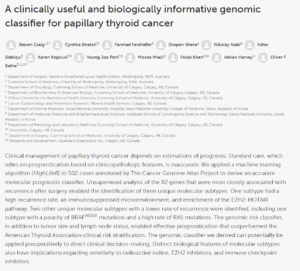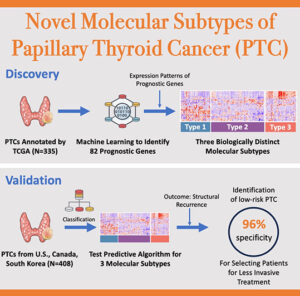Front. Endocrinol., 12 September 2023
Sec. Thyroid Endocrinology
Volume 14 – 2023
Clinical management of papillary thyroid cancer depends on estimations of prognosis. Standard care, which relies on prognostication based on clinicopathologic features, is inaccurate. We applied a machine learning algorithm (HighLifeR) to 502 cases annotated by The Cancer Genome Atlas Project to derive an accurate molecular prognostic classifier. Unsupervised analysis of the 82 genes that were most closely associated with recurrence after surgery enabled the identification of three unique molecular subtypes. One subtype had a high recurrence rate, an immunosuppressed microenvironment, and enrichment of the EZH2-HOTAIR pathway. Two other unique molecular subtypes with a lower rate of recurrence were identified, including one subtype with a paucity of BRAFV600E mutations and a high rate of RAS mutations. The genomic risk classifier, in addition to tumor size and lymph node status, enabled effective prognostication that outperformed the American Thyroid Association clinical risk stratification. The genomic classifier we derived can potentially be applied preoperatively to direct clinical decision-making. Distinct biological features of molecular subtypes also have implications regarding sensitivity to radioactive iodine, EZH2 inhibitors, and immune checkpoint inhibitors.
Read the full paper here


